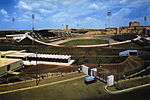Santi Pietro e Paolo a Via Ostiense
20th-century Roman Catholic church buildings in ItalyAll pages needing cleanupItalian fascist architectureRome Q. XXXII EuropaTitular churches ... and 1 more
Wikipedia pages needing cleanup from May 2015

The basilica of Santi Pietro e Paolo a Via Ostiense is one of the titular churches in Rome, to which Cardinal-Priests are appointed. It is a modern building at Piazzale dei Santi Pietro e Paolo 8 in EUR (Esposizione Universale Roma). It is at the west end of the Viale Europa, the last two blocks of which is a monumental approach reserved for pedestrians and paved with polychrome marble.
Excerpt from the Wikipedia article Santi Pietro e Paolo a Via Ostiense (License: CC BY-SA 3.0, Authors, Images).Santi Pietro e Paolo a Via Ostiense
Piazzale dei Santi Pietro e Paolo, Rome Europa
Geographical coordinates (GPS) Address Website External links Nearby Places Show on map
Geographical coordinates (GPS)
| Latitude | Longitude |
|---|---|
| N 41.8337 ° | E 12.4593 ° |
Address
Basilica parrocchiale dei Santi Pietro e Paolo
Piazzale dei Santi Pietro e Paolo
00144 Rome, Europa
Lazio, Italy
Open on Google Maps








